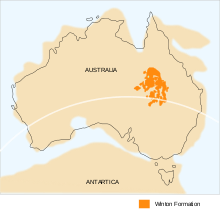Winton Formation

| Winton Formation Stratigraphic range: Latest Albian-Early Cenomanian[1] | |
|---|---|
| Type | Geological formation |
| Overlies | Mackunda Formation[2] |
| Location | |
| Region | Queensland |
| Country | Australia |
The Winton Formation is a Cretaceous formation in central-western Queensland, Australia. The sauropod dinosaur Austrosaurus is found in the early Cretaceous Winton formation.
The formation is a rock unit that blankets large areas of central-western Queensland. It consists of sedimentary rocks such as sandstone, siltstone and claystone. The sediments that make up these rocks represent the remnants of the river plains that filled the basin left by the Eromanga Sea - an inland sea that covered large parts of Queensland and central Australia at least four times during the Early Cretaceous. Great meandering rivers, forest pools and swamps, creeks, lakes and coastal estuaries, all left behind different types of sediment.
| Wikinews has related news: Three new dinosaurs discovered in Australia |
In some areas, the Winton Formation is over 400 metres thick. To bring with them such a huge amount of sediment, the rivers that flowed across these plains must have been comparable in size to the present day Amazon or Mississippi rivers . As more and more sediment was brought in, the margins of the inland sea slowly contracted. By around 95 million years ago, the job was complete and the inland sea would never be seen again.
By virtue of its age and the environmental conditions under which the rocks it consists of were deposited, the Winton Formation represents one of the richest sources of dinosaur fossils anywhere in Australia.
Fauna
A fossil footprint-(ichnite), Wintonopus, found with two other dinosaur genera footprints at the Lark Quarry in Australia, c.f. Tyrannosauropus and Skartopus, have been found in the Winton Formation.
| Dinosaurs of the Winton Formation | ||||
|---|---|---|---|---|
| Taxa | Presence | Description | Images | |
|
Genus:
|
|
2 meters (6.6 ft) tall and 6 meters (20 ft) long lightweight predatory theropod[5][6][7] | ||
|
Genus:
|
|
Giant herbivorous sauropod about 52 feet (16 m) in length.[5] | ||
|
Genus:
|
|
Giant, stocky herbivorous sauropod about 52 feet (16 m) in length.[5] | ||
|
Genus:
|
|
|||
|
|
|||
|
Order:
|
|
|||
|
Order:
|
|
|||
|
Infraorder: |
||||
See also
- Lark Quarry Conservation Park
- List of dinosaur-bearing rock formations
References
- ↑ http://www.uq.edu.au/dinosaurs/index.html?page=14156
- ↑ http://www.anra.gov.au/topics/water/availability/qld/gmu-winton-mackunda-formations.html
- ↑ 3.0 3.1 3.2 3.3 3.4 3.5 Hocknull SA, White MA, Tischler TR, Cook AG, Calleja ND, et al. (2009). "New Mid-Cretaceous (Latest Albian) Dinosaurs from Winton, Queensland, Australia". PLoS ONE 4(7): e6190. doi:10.1371/journal.pone.0006190
- ↑ 4.0 4.1 4.2 4.3 4.4 4.5 4.6 4.7 4.8 4.9 4.10 4.11 4.12 4.13 4.14 4.15 4.16 4.17 4.18 4.19 Weishampel, David B; et al. (2004). "Dinosaur distribution (Late Cretaceous, Australasia)." In: Weishampel, David B.; Dodson, Peter; and Osmólska, Halszka (eds.): The Dinosauria, 2nd, Berkeley: University of California Press. Pp. 605-606. ISBN 0-520-24209-2.
- ↑ 5.0 5.1 5.2 "Scientists Find Dinosaur That Lived 98M Years Ago in Australia". Associated Press. Fox News. 3 July 2009. Retrieved 2009-07-03.
- ↑ "New dinosaurs found in Australia". BBC News. 3 July 2009. Retrieved 2009-07-03.
- ↑ "Triple Fossil Find Puts Australia Back On The Dinosaur Map". Science Daily. 3 July 2009. Retrieved 2009-07-03.